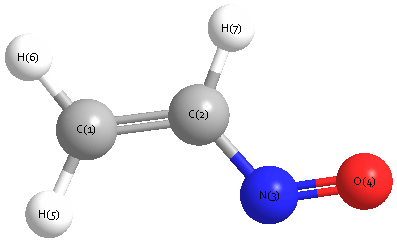Vibrational Frequencies calculated at B2PLYP/daug-cc-pVTZ
| Mode Number |
Symmetry |
Frequency
(cm-1) |
Scaled Frequency
(cm-1) |
IR Intensities
(km mol-1) |
Raman Act
(Å4/u) |
Dep P |
Dep U |
|---|
| 1 |
A' |
3274 |
3274 |
0.23 |
56.89 |
0.67 |
0.80 |
| 2 |
A' |
3184 |
3184 |
4.13 |
169.47 |
0.12 |
0.22 |
| 3 |
A' |
3169 |
3169 |
1.80 |
19.85 |
0.39 |
0.56 |
| 4 |
A' |
1668 |
1668 |
2.01 |
49.90 |
0.11 |
0.20 |
| 5 |
A' |
1507 |
1507 |
101.33 |
60.76 |
0.41 |
0.59 |
| 6 |
A' |
1425 |
1425 |
26.58 |
28.45 |
0.35 |
0.52 |
| 7 |
A' |
1292 |
1292 |
1.73 |
9.18 |
0.22 |
0.36 |
| 8 |
A' |
1149 |
1149 |
80.49 |
31.73 |
0.40 |
0.57 |
| 9 |
A' |
900 |
900 |
31.34 |
0.66 |
0.75 |
0.86 |
| 10 |
A' |
613 |
613 |
1.20 |
9.96 |
0.10 |
0.19 |
| 11 |
A' |
352 |
352 |
1.10 |
0.62 |
0.69 |
0.81 |
| 12 |
A" |
1010 |
1010 |
8.40 |
3.79 |
0.75 |
0.86 |
| 13 |
A" |
1007 |
1007 |
45.77 |
0.23 |
0.75 |
0.86 |
| 14 |
A" |
689 |
689 |
0.99 |
0.55 |
0.75 |
0.86 |
| 15 |
A" |
179 |
179 |
0.08 |
0.26 |
0.75 |
0.86 |
Unscaled Zero Point Vibrational Energy (zpe) 10707.9 cm
-1
Scaled (by 1) Zero Point Vibrational Energy (zpe) 10707.9 cm
-1
See section
III.C.1 List or set vibrational scaling factors
to change the scale factors used here.
See section
III.C.2
Calculate a vibrational scaling factor for a given set of molecules
to determine the least squares best scaling factor.
Charges, Dipole, Quadrupole and Polarizability
Charges from optimized geometry at B2PLYP/daug-cc-pVTZ
Charges (e)
| Number |
Element |
Mulliken |
CHELPG |
AIM |
ESP |
| 1 |
C |
-1.147 |
|
|
|
| 2 |
C |
-0.065 |
|
|
|
| 3 |
N |
-0.405 |
|
|
|
| 4 |
O |
-0.669 |
|
|
|
| 5 |
H |
0.547 |
|
|
|
| 6 |
H |
0.438 |
|
|
|
| 7 |
H |
1.302 |
|
|
|
Electric dipole moments
Electric dipole components in Debye
(What's a Debye? See section
VII.A.3)
| |
x |
y |
z |
Total |
| |
1.402 |
2.958 |
0.000 |
3.274 |
| CHELPG |
|
|
|
|
| AIM |
|
|
|
|
| ESP |
|
|
|
|
Electric Quadrupole moment
Quadrupole components in D Å
| Primitive |
|---|
| | x | y | z |
|---|
| x |
-22.988 |
0.024 |
-0.006 |
| y |
0.024 |
-23.723 |
-0.007 |
| z |
-0.006 |
-0.007 |
-24.027 |
|
| Traceless |
|---|
| | x | y | z |
|---|
| x |
0.887 |
0.024 |
-0.006 |
| y |
0.024 |
-0.215 |
-0.007 |
| z |
-0.006 |
-0.007 |
-0.671 |
|
| Polar |
|---|
| 3z2-r2 | -1.343 |
|---|
| x2-y2 | 0.735 |
|---|
| xy | 0.024 |
|---|
| xz | -0.006 |
|---|
| yz | -0.007 |
|---|
|
Polarizabilities
Components of the polarizability tensor.
Units are
Å
3 (Angstrom cubed)
Change units.
| |
x |
y |
z |
| x |
7.386 |
2.061 |
0.001 |
| y |
2.061 |
7.161 |
0.001 |
| z |
0.001 |
0.001 |
3.935 |
<r2> (average value of r
2) Å
2
| <r2> |
76.217 |
| (<r2>)1/2 |
8.730 |
